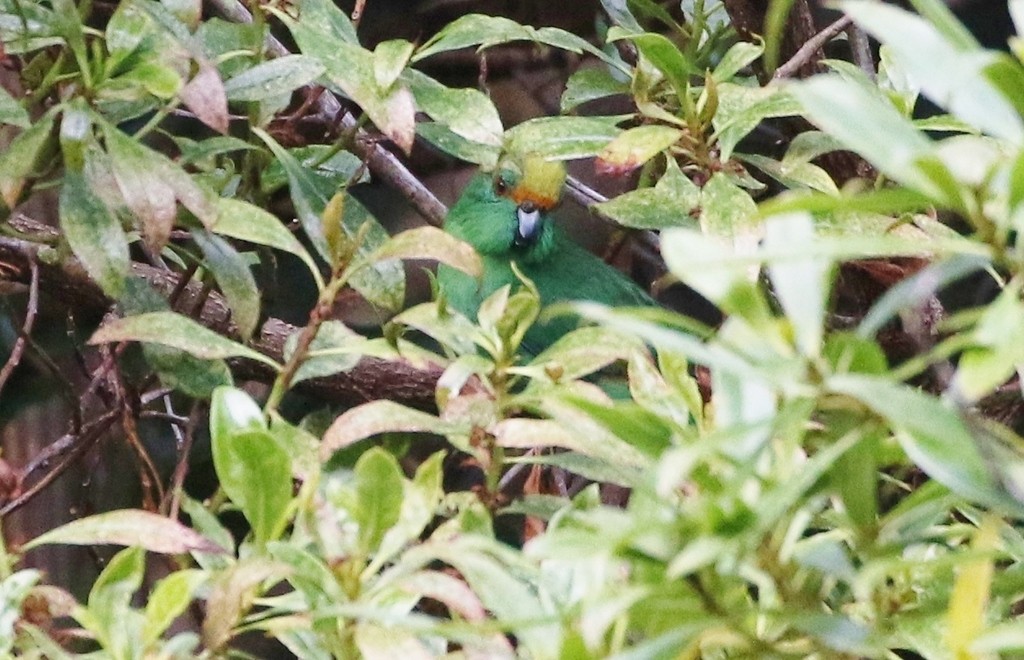Malherbe's Parakeet
A species of Southwest Pacific Parakeets, Also known as Orange-fronted Kākāriki Scientific name : Cyanoramphus malherbi Genus : Southwest Pacific Parakeets
Malherbe's Parakeet, A species of Southwest Pacific Parakeets
Also known as:
Orange-fronted Kākāriki
Botanical name: Cyanoramphus malherbi
Genus: Southwest Pacific Parakeets
Content
Description General Info
 Photo By silversea_starsong , used under CC-BY-NC-4.0 /Cropped and compressed from original
Photo By silversea_starsong , used under CC-BY-NC-4.0 /Cropped and compressed from original Description
Cyanoramphus malherbi is a medium size parrot, approximately 20 centimetres long. Its body is primarily a bright blue-green, with azure blue primary covert and leading edge feathers on its wings. It has a distinctive (and diagnostic) orange frontal band on its yellow crown, but this is absent in juvenile birds, which have fully green heads. The orange frontal band begins to develop when the bird is 2–5 weeks old. Its rump has orange patches on the sides. Colouration in males tends to be brighter, and juveniles are distinctly duller. The only reliable features that separate mature orange-fronted parakeets from the similar yellow-crowned parakeet (C. auriceps) are the colour of the frontal band and rump. 
Size
20 cm
Nest Placement
Cavity
Feeding Habits
Malherbe's Parakeet primarily forage in beech canopies, eating seeds, flowers, buds, and invertebrates. Beech seeds dominate during mast years. Ground foraging involves herbs and ferns, with a higher plant diversity and fewer invertebrates consumed by the Maud Island population.
Habitat
The habitat of malherbe's Parakeet predominantly encompasses the edges of Nothofagus, or southern beech, forests. These birds exhibit a preference for areas adjacent to stands of certain Nothofagus species, though they have been reported from various forest types. Translocated populations inhabit ecotones, which are transitional zones between broadleaf coastal forests and manuka scrub, as well as pine plantations bordering manuka scrub.
Dite type
Herbivorous
General Info
Feeding Habits
Bird food type
Distribution Area
The species is found in only three regions on New Zealand's South Island: the South Branch Hurunui River valley, Hawdon River valley, and the Poulter valley. In addition, there are four translocated populations, found on Maud Island, Blumine Island, Chalky Island, and Mayor Island / Tuhua. In the South Island, the parakeet is predominantly found only in Nothofagus/Fuscospora (beech) forest with some reports from alpine and subalpine tussock and open matagouri shrubland. On Maud Island, one study found that the parakeet prefers areas with greater canopy cover and lower understory and ground cover. The species is not restricted to this type of forest, however, and as its population density increases it may make more use of other habitats. 
Species Status
Predator management is the main strategy to reverse this species' decline. All three mainland populations come under the "Operation Ark" initiative, which controls stoat, possum and rat populations through integrated pest management,with particular focus on reducing the effect of predator plagues. These pest management strategies have worked with other New Zealand bird species to reduce predation by introduced mammals. Individual nest sites are also protected from predators using metal tree-trunk wraps; this has been a successful programme and only one nest out of 153 has been lost to predators since 2003. The other major conservation strategy is captive breeding programmes carried out at Peacock Springs by the Isaac Wildlife Trust, with individuals being released on predator-free islands. Birds are placed in portable aviaries in the forest to acclimatise them before release. A total of 45 birds were released between 2005 and 2007 on Chalky Island, off the coast of Fiordland. The local population had increased to 150 individuals in 2009, and 100–200 by 2011, but had declined to 50–150 individuals in 2013. Sixty-eight individuals were released on Maud Island in the Marlborough Sounds between 2007 and 2009, but 2013 the island's population consisted of only 10–20 birds. Orange-fronted parakeets have also been translocated to Mayor Island / Tuhua in the Bay of Plenty and Blumine Island in the Marlborough Sounds; estimated population in 2013 were 50–150 and 50–100 birds respectively. These two populations, however, are not as well studied as those on Chalky Island and Maud Island. 